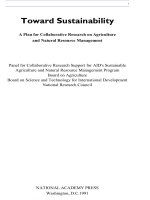A bivariate infinitely divesible distribution with exponential and Mittag-Leffler marginals
Bạn đang xem bản rút gọn của tài liệu. Xem và tải ngay bản đầy đủ của tài liệu tại đây (219.82 KB, 6 trang )
Author's personal copy
Statistics and Probability Letters 79 (2009) 1596–1601
Contents lists available at ScienceDirect
Statistics and Probability Letters
journal homepage: www.elsevier.com/locate/stapro
A bivariate infinitely divisible distribution with exponential and
Mittag–Leffler marginals
Tomasz J. Kozubowski
a,∗
, Mark M. Meerschaert
b
a
Department of Mathematics and Statistics, University of Nevada, Reno NV 89557, USA
b
Department of Statistics and Probability, Michigan State University, A416 Wells Hall, East Lansing, MI 48824, USA
a r t i c l e i n f o
Article history:
Received 17 November 2008
Received in revised form 24 March 2009
Accepted 25 March 2009
Available online 31 March 2009
MSC:
primary 60E07
secondary 60F05
60G50
62H05
a b s t r a c t
We introduce a bivariate distribution supported on the first quadrant with exponential,
and heavy tailed Mittag–Leffer, marginal distributions. Although this distribution belongs
to the class of geometric operator stable laws, it is a rather special case that does not follow
their general theory. Our results include the joint density and distribution function, Laplace
transform, conditional distributions, joint moments, and tail behavior. We also establish
infinite divisibility and stability properties of this model, and clarify its connections with
operator stable and geometric operator stable laws.
© 2009 Elsevier B.V. All rights reserved.
1. Introduction
Suppose that X
1
is a stable subordinator with scale parameter σ > 0 and Laplace transform (LT)
Ee
−tX
1
= e
−σ
α
t
α
, t ∈ R
+
, (1.1)
and let E be a standard exponential random variable, independent of X
1
. In this paper we consider a bivariate distribution
defined through the stochastic representation
Y = (Y
1
, Y
2
)
d
= (E
1/α
X
1
, ηE), η > 0. (1.2)
Clearly, the marginal distribution of Y
2
is exponential with mean η and the probability density function (PDF)
f (x) =
1
η
e
−x/η
, x > 0. (1.3)
On the other hand, Y
1
has the Mittag–Leffler distribution (see, e.g., Pillai, 1990) with the LT
Ee
−tY
1
=
1
1 + σ
α
t
α
, t ∈ R
+
, (1.4)
and the PDF
f
1
(y) =
sin πα
σ π
∞
0
u
α
e
−xu/σ
du
1 + u
2α
+ 2u
α
cos πα
=
1
σ
∞
0
z
−1/α
s
α
y
σ z
1/α
e
−z
dz, (1.5)
∗
Corresponding author. Tel.: +1 775 7846643; fax: +1 775 7846378.
E-mail address: (T.J. Kozubowski).
0167-7152/$ – see front matter © 2009 Elsevier B.V. All rights reserved.
doi:10.1016/j.spl.2009.03.024
Author's personal copy
T.J. Kozubowski, M.M. Meerschaert / Statistics and Probability Letters 79 (2009) 1596–1601 1597
where s
α
is the density of the standard stable subordinator (σ = 1 in (1.1)). We shall refer to the above distribution as BEML
distribution (bivariate with exponential and Mittag-Leffler marginals), denoting it by BEML
α
(σ , η).
The exponential distribution is one of the most important models of applied probability, with many applications in almost
any area of applied research. Its generalization and younger sibling – the Mittag–Leffler distribution, also known as positive
Linnik law (see, e.g., Christoph and Schreiber, 2000; Huillet, 2000; Lin, 2001) – has gained popularity in recent years due
to its connections with the stochastic solution of the Cauchy problem for PDEs with fractional derivatives (see, e.g, Fulger
et al., 2008, and the references therein) and relaxation theory in complex, disordered systems (see, e.g., Kotulski, 1995;
Weron and Kotulski, 1996). This model was studied in the context of random stability (see, e.g., Bunge, 1996; Jayakumar and
Suresh, 2003; Klebanov et al., 2006; Kozubowski, 1994) as a special case of geometric stable laws (see, e.g., Klebanov et al.,
2006, and the references therein) and extended to time series (see, e.g., Jayakumar, 2003; Jayakumar and Pillai, 1993a), and
its theoretical properties and applications has attracted the attention of numerous researchers (see, e g, Jayakumar, 2003;
Jayakumar and Pillai, 1993b, 1996; Jayakumar and Suresh, 2003; Kozubowski, 2001; Lin, 1998; Pillai, 1990). The bivariate
model that links the two distributions should also be valuable for modeling data with both power and exponential tail
behavior of one dimensional components. In particular, as we shall see below, this bivariate distribution provides a useful
approximation of the magnitude X and duration N connected with hydro-climatic episodes (see, e.g., Biondi et al., 2005),
where
(X, N)
d
=
N
p
i=1
u
(i)
, N
p
=
N
p
i=1
(u
(i)
, 1) (1.6)
and the parameter p ∈ (0, 1) is close to zero. Here, the {u
(i)
} are independent and identically distributed (IID) positive
quantities with infinite mean (representing a climatic variable such as precipitation) while the N
p
is independent of the {u
(i)
}
geometric random variables with distribution
P(N
p
= n) = p(1 − p)
n−1
, n ∈ N, (1.7)
representing the number of climatic events (such as rainfall events) in a given time interval. This provides a heavy-tail
generalization of the case where the {u
(i)
} are light tailed (e.g., exponential), where the BEG model of Kozubowski and
Panorska (2005) and its generalizations (see Kozubowski et al., 2008) are useful in approximating the distribution (1.6).
This new model should also play an important role in other areas where events of random magnitudes occur independently
in time, and the joint distribution of their number and the total magnitude is of concern. Examples include insurance claims
in actuarial science, or magnitudes of earthquakes in geophysics.
In Section 2 we present basic properties of the BEML model, including the joint density and distribution function, Laplace
transform, conditional distributions, joint moments, and tail behavior, as well as its divisibility and stability properties. In
Section 3 we clarify its connections with operator stable and geometric operator stable laws, and briefly mention possible
applications.
2. Definition and basic properties
Suppose that X
1
is a stable subordinator with the LT (1.1). Then the random vector X = (X
1
, X
2
), where X
2
= η > 0
(constant with probability one), has the LT of the form
φ(t, s) = Ee
−tX
1
−sX
2
= e
−σ
α
t
α
−ηs
, (t, s) ∈ R
2
+
. (2.1)
This infinitely divisible distribution is operator stable (see, e.g., Jurek and Mason, 1993; Meerschaert and Scheffler, 2001), in
the sense that
A
n
n
i=1
X
(i)
d
= X, n ∈ N, (2.2)
where the {X
(i)
} are IID copies of X and
A
n
=
n
−1/α
0
0 n
−1
:= diag(n
−1/α
, n
−1
). (2.3)
Note that we can also write A
n
= n
−B
= exp(−B log n), where B = diag(1/α, 1) and exp(A) = I + A + A
2
/2! + · · · is the
usual matrix exponential. The matrix B is called an exponent of the operator stable random vector X, see Meerschaert and
Scheffler (2001). It follows that the random vector Y with the LT
ψ(t, s) =
1
1 − log φ(t, s)
=
1
1 + σ
α
t
α
+ ηs
, (t, s) ∈ R
2
+
, (2.4)
is (strictly) operator geometric stable (cf. Kozubowski et al., 2005), that is
A
p
N
p
i=1
Y
(i)
d
= Y , p ∈ (0, 1). (2.5)
Author's personal copy
1598 T.J. Kozubowski, M.M. Meerschaert / Statistics and Probability Letters 79 (2009) 1596–1601
Here, Y, Y
(1)
, Y
(2)
, . . . are IID random vectors with the LT (2.4), N
p
is a geometric variable (1.7), independent of the {Y
(i)
},
and A
p
= p
B
. Moreover, we have Y
d
= E
B
X, that is we have the stochastic representation (1.2). The following definition
summarizes this discussion.
Definition 2.1. A random vector Y = (Y
1
, Y
2
) given by the LT (2.4) or the stochastic representation (1.2), where E is standard
exponential and X
1
is a stable subordinator with LT (1.1), independent of E, is said to have a BEML distribution with tail
parameter α ∈ (0, 1) and scale parameters σ , η > 0. This distribution is denoted by BEML
α
(σ , η).
It is clear from the above representation, that the conditional distribution of Y
1
given Y
2
= y > 0 coincides with that of
σ
y
W , where W is a standard stable subordinator (with scale parameter equal to 1) and
σ
y
=
σ y
1/α
η
1/α
. (2.6)
Since the marginal density of Y
2
is the exponential PDF (1.3), we immediately obtain the following result concerning the
PDF of a BEML random vector.
Theorem 2.2. The distribution function and density of Y = (Y
1
, Y
2
) ∼ BEML
α
(σ , η) are, respectively,
F(y
1
, y
2
) =
y
2
/η
0
S
α
y
1
σ z
1/α
e
−z
dz, (y
1
, y
2
) ∈ R
2
+
, (2.7)
and
f (y
1
, y
2
) =
η
1/α−1
e
−y
2
/η
σ y
1/α
2
s
α
η
1/α
y
1
σ y
1/α
2
, (y
1
, y
2
) ∈ R
2
+
, (2.8)
where S
α
and s
α
are, respectively, the distribution function and the PDF of the standard stable subordinator.
Dividing the joint PDF (2.8) by the marginal PDF of Y
1
given by (1.5) leads to the conditional PDF of Y
2
given Y
1
= y > 0,
described in our next result.
Theorem 2.3. Let Y = (Y
1
, Y
2
) ∼ BEML
α
(σ , η).
(i) The conditional distribution of Y
2
|Y
1
= y > 0 is weighted exponential with the PDF
f
Y
2
|Y
1
=y
(y
2
) =
ω(y
2
)(1/η)e
−y
2
/η
∞
0
ω(x)(1/η)e
−x/η
dx
, y
2
> 0. (2.9)
The weight function in (2.9) is
ω(x) = x
−1/α
s
α
yη
1/α
σ x
1/α
, x > 0, (2.10)
where s
α
is the density of the standard stable subordinator.
(ii) The conditional distribution of Y
1
|Y
2
= y > 0 is the same as that of σ
y
W , where W is a standard stable subordinator and σ
y
is given by (2.6).
The following two results deal with tail behavior and joint moments of BEML variables. In the first result, which is
straightforward to prove by a Tauberian argument (compare with Samorodnitsky and Taqqu (1994, Property 1.2.15)), we
present the exact tail behavior of linear combinations of the components of an BEML random vector, showing that they are
heavy tailed with the same tail index α.
Theorem 2.4. Let Y = (Y
1
, Y
2
) ∼ BEML
α
(σ , η) and let (a, b) ∈ R
2
+
with a
2
+ b
2
> 0. Then, as x → ∞, we have
P(aY
1
+ bY
2
> x) ∼
(aσ )
α
Γ (1 − α)
x
−α
for a = 0,
e
−
x
bη
for a = 0.
(2.11)
In the second result we give conditions for the existence of joint moments of BEML random vectors.
Theorem 2.5. Let Y = (Y
1
, Y
2
) ∼ BEML
α
(σ , η) and let α
1
, α
2
≥ 0. Then the joint moment E|Y
1
|
α
1
|Y
2
|
α
2
exists if and only if
α
1
< α, in which case we have
E|Y
1
|
α
1
|Y
2
|
α
2
=
σ
α
1
η
α
2
Γ
α
1
α
+ α
2
+ 1
Γ
1 −
α
1
α
Γ (1 − α
1
)
. (2.12)
Author's personal copy
T.J. Kozubowski, M.M. Meerschaert / Statistics and Probability Letters 79 (2009) 1596–1601 1599
Proof. The result follows from (1.2) and well-known moment conditions and formulas for standard exponential and
standard α-stable subordinator variables E and W , respectively,
EE
p
= Γ (1 + p) for p > 0, EW
p
=
Γ (1 − p/α)
Γ (1 − p)
for 0 < p < α.
Remark 2.6. Note that for α
2
= 0 we obtain absolute moments of the Mittag–Leffler distribution (see, e.g., Kozubowski
and Panorska, 1996) while for α
1
= 0 we get fractional moments of the exponential distribution with mean η. The above
formula may be useful in estimating the parameters of BEML laws.
2.1. Divisibility and stability properties
A random vector Y (and its probability distribution) is said to be geometric infinitely divisible (GID) if for all p ∈ (0, 1) we
have
Y
d
=
N
p
i=1
Y
(pi)
, (2.13)
where N
p
is geometrically distributed random variable (1.7), the variables {Y
(pi)
} are IID for each p, and N
p
and {Y
(pi)
} are
independent (see, e.g., Klebanov et al., 1984). It is well known that both exponential and ML distributions are GID. Our next
result shows that the same property is shared by the BEML distributions.
Proposition 2.7. Let Y be BE ML
α
(σ , η) with LT (2.4). Then Y is GID and the relation (2.13) holds where the {Y
(pi)
} have the
BE ML
α
(p
1/α
σ , pη) distribution.
Proof. Let ψ and ψ
p
be the LTs of Y and the {Y
(pi)
}, respectively. Then, the relation (2.13) takes the form
ψ(t, s) =
pψ
p
(t, s)
1 − (1 − p)ψ
p
(t, s)
,
which is easily shown to hold when ψ and ψ
p
are the LTs corresponding to the BE ML
α
(σ , η) and BE ML
α
(p
1/α
σ , pη)
distributions, respectively.
Remark 2.8. We note that the BEML distributions are infinitely divisible in the classical sense as well. Indeed, for each
integer n ≥ 1 their LT (2.4) can be expressed as the nth power of ψ
1/n
(t, s), where
ψ
u
(t, s) =
1
1 + σ
α
t
α
+ ηs
u
, (t, s) ∈ R
2
+
, u > 0, (2.14)
is the LT of a random vector given by (1.2) with X
1
as before and E having a standard gamma distribution with shape
parameter u. In this context, the BEML distribution arises as the distribution of Y (1), where {Y(u), u > 0} is a bivariate
Lévy process with marginal distributions of Y(u) given by the LT (2.14).
We have already seen above that the BEML distributions have the stability proposition (2.5) with A
p
= diag(p
1/α
, p). The
following result, which is an extension of corresponding stability properties of univariate Mittag–Leffler and exponential
distributions (see, e.g., Kotz et al., 2001) and parallels Theorem 3.11 in Kozubowski et al. (2005), shows this property provides
a characterization of this class.
Theorem 2.9. Let Y , Y
(1)
, Y
(2)
, . . . be IID positive bivariate random vectors whose second components have finite mean, and let
N
p
be a geometrically distributed random variable independent of the sequence {Y
(i)
}. Then
S
p
= A
p
N
p
i=1
(Y
(i)
+ b
p
)
d
= Y , p ∈ (0, 1), (2.15)
with some diagonal {A
p
} and b
p
∈ R
2
if and only if Y has a BEML distribution given by the LT (2.4). Moreover, we must necessarily
have b
p
= 0 and A
p
= diag(p
1/α
, p) for each p, where 0 < α ≤ 1.
Proof. This follows from Theorem 3.9 in Kozubowski et al. (2005) and similar result for geometric stable distributions
(see Kozubowski, 1994, Theorem 3.2), where we take into account that the stability relation holds for each coordinate
of Y.
3. Operator geometric stable laws and domains of attraction
Operator stable random vectors are the weak distributional limits of sums of independent and identically distributed
random vectors. Given U, U
(1)
, U
(2)
. . . IID random vectors, we say that U belongs to the strict generalized domain of
Author's personal copy
1600 T.J. Kozubowski, M.M. Meerschaert / Statistics and Probability Letters 79 (2009) 1596–1601
attraction (GDOA) of the random vector X if we have the weak convergence
A
n
n
i=1
U
(i)
⇒ X, (3.1)
in which case we also say that X is strictly operator stable (OS). If we assume that the limit X is full (i.e., not supported on
any lower dimensional affine subspace) then the convergence (3.1) has a number of consequences. The same limit can be
obtained for a sequence of norming operators that is regularly varying, in the sense that A
[λn]
A
−1
n
→ λ
−B
in the operator
norm for every λ > 0. Here B is an exponent of X, so that if X
(i)
are IID copies of X, the random vectors n
B
X and X
(1)
+· · ·+X
(n)
are identically distributed. The exponent also codes the tail behavior of U, see Meerschaert and Scheffler (2001) for details.
It is customary to assume that X is full to ensure that the limit in (3.1) can serve as a useful approximation of the normalized
sum (i.e.,
n
n=1
U
(i)
≈ A
−1
n
X). For example, it ensures that A
n
is invertible. However, the fullness assumption is not strictly
necessary to develop a useful theory of GDOA for OS laws.
Suppose that u
(i)
are IID random variables in the strict domain of normal attraction of the stable subordinator X
1
, so that
n
−1/α
n
i=1
u
(i)
⇒ X
1
as n → ∞. (Note: The term ‘‘normal’’ here refers to the norming constants, not the limit.) Define random vectors
U
(i)
= (u
(i)
, 1) where the second coordinate is non-random. Now it is easy to see that
n
−B
n
i=1
U
(i)
⇒ X = (X
1
, 1), (3.2)
where B = diag(1/α, 1). Hence X is operator stable, but not full. We can also see that n
B
X ≈
n
i=1
U
(i)
is a useful
approximation, since this is equivalent to
n
i=1
u
(i)
≈ n
1/α
X
1
.
Operator geometric stable random vectors are the weak distributional limits of random sums of IID random vectors,
with a geometrically distributed number of summands (see Kozubowski et al., 2005). Suppose that N
p
has a geometric
distribution (1.7). Given U, U
(1)
, U
(2)
. . . IID random vectors, we say that U belongs to the strict generalized geometric
domain of attraction (GGDOA) of the random vector Y if
A
p
N
p
i=1
U
(i)
⇒ Y , (3.3)
in which case we also say that Y is strictly operator geometric stable (OGS). It follows that, if Y
(i)
are IID copies of Y , then
p
B
Y and Y
(1)
+ · · · + Y
(N
p
)
are identically distributed for any p > 0, where again N
p
is geometric and independent of
Y , Y
(1)
, Y
(2)
, . . . and B is some linear operator called an exponent of Y .
The basic theory of OGS laws and GGDOA is laid out in Kozubowski et al. (2005). If X is OS with exponent B, and E
is standard exponential, independent of X, then Y = E
B
X is OGS with the same exponent. Conversely, if Y is OGS with
exponent B, then it can always be written in the form Y = E
B
X where X is OS with the same exponent. A companion paper
(see Kozubowski et al., 2003) relates GDOA and GGDOA. Theorem 3.3 in that paper implies that, if U belongs to the GDOA of
X, then it also belongs to the GGDOA of Y , and vice versa. Hence the GDOA of X and the GGDOA of Y = E
B
X are equal. Both
papers (Kozubowski et al., 2003, 2005) assume that X and Y are full. It is not hard to see that X full implies that Y = E
B
X
is full. However, the converse is not true, as we shall soon illustrate. Hence it is useful to note that, even without assuming
X full, the same arguments from Kozubowski et al. (2003, 2005) allow us to conclude that Y OGS with exponent B implies
Y = E
B
X for some (not necessarily full) OS random vector X, and that any U in the GGDOA of Y also belongs to the GDOA
of X. In fact, the argument extends immediately, since the fundamental results of Rosiński (1976) used in Kozubowski et al.
(2003) do not require fullness.
If (3.2) holds for IID random vectors U
(i)
= (u
(i)
, 1), where the u
(i)
belong to the strict domain of normal attraction of
X
1
, then Theorem 1 in Rosiński (1976) yields that (3.3) also holds, where Y = E
B
X and B = diag(1/α, 1). It follows that
the BEML random vector Y is OGS with exponent B, and the bivariate distribution of (X, N) in (1.6) can be approximated by
A
−1
p
Y . Note that, although Y is full, the OS random vector X is not full.
OGS laws are a special case of ν-operator stable laws (see Kozubowski et al., 2003). If (3.2) holds for IID random vectors
U
(i)
= (u
(i)
, 1), where the u
(i)
belong to the strict domain of normal attraction of X
1
, and if N
n
are integer valued random
variables independent of U
(i)
such that N
n
/n ⇒ E > 0 then Theorem 1 in Rosiński (1976) shows that (3.3) still holds with
Y = E
B
X. Even in the case where N
n
are U
(i)
are dependent, the same holds under the stronger assumption that N
n
/n → E
in probability. This follows from Theorem 2.4 of Becker-Kern (2002). Finally, we note that if X(t) is an operator stable Lévy
process such that X(1) is infinitely divisible (ID) with X , then Y is ID with X (E), since X(t) is operator self-similar with
exponent B: the finite dimensional distributions of the stochastic processes X(ct) and c
B
X(t) are equal.
Author's personal copy
T.J. Kozubowski, M.M. Meerschaert / Statistics and Probability Letters 79 (2009) 1596–1601 1601
Acknowledgements
The research of the first author was partially supported by NSF grant ATM-0503722. The research of the second author
was partially supported by NSF grants DMS-0803360 and EAR-0823965. The authors thank the referee for the helpful
comments.
References
Becker-Kern, P., 2002. Limit theorems with random sample size for generalized domains of semistable attraction. J. Math. Sci. 111, 3820–3829.
Biondi, F., Kozubowski, T.J., Panorska, A.K., 2005. A new model for quantifying climate episodes. Int. J. Climatol. 25, 1253–1264.
Bunge, J., 1996. Composition semigroups and random stability. Ann. Probab. 24, 1476–1489.
Christoph, G., Schreiber, K., 2000. Positive Linnik and discrete Linnik distributions. In: Balakrishnan, N., et al. (Eds.), Asymptotic Methods in Probability and
Statistics. Birkhäuser, Boston, pp. 3–18.
Fulger, D., Scalas, E., Germano, G., 2008. Monte-Carlo simulation of uncoupled continuous-time random walks yielding a stochastic solution of the
space–time fractional diffusion equation. Phys. Rev. E 77, 021122.
Huillet, T., 2000. On Linnik’s continuous-time random walk. J. Phys. A 33, 2631–2652.
Jayakumar, K., 2003. Mittag–Leffler Process. Math. Comput. Modelling 37, 1427–1434.
Jayakumar, K., Pillai, R.N., 1993a. The first order autoregressive Mittag–Leffler process. J. Appl. Probab. 30, 462–466.
Jayakumar, K., Pillai, R.N., 1993b. Mittag–Leffler distributions and applications. Department of Statistics Monograph, University of Kerala.
Jayakumar, K., Pillai, R.N., 1996. Characterizations of Mittag–Leffler distribution. J. Appl. Statist. Sci. 4, 77–82.
Jayakumar, K., Suresh, R.P., 2003. Mittag–Leffler distributions: A review. J. Indian Soc. Probab. Statist. 7, 51–71.
Jurek, Z., Mason, J.D., 1993. Operator-Limit Distributions in Probability Theory. Wiley, New York.
Klebanov, L.B., Maniya, G.M., Melamed, I.A., 1984. A problem of Zolotarev and analogs of infinitely divisible and stable distributions in a scheme for summing
a random number of random variables. Theory Probab. Appl. 29, 791–794.
Klebanov, L.B., Kozubowski, T.J., Rachev, S.T., 2006. Ill Posed Problems in Probability and Stability of Random Sums. Nova Science Publishers, New York.
Kotulski, M., 1995. Asymptotic distributions of the continuous time random walks: a probabilistic approach. J. Statist. Phys. 81, 777–792.
Kotz, S., Kozubowski, T.J., Podgórski, K., 2001. The Laplace Distribution and Generalizations: A Revisit with Applications to Communications, Economics,
Engineering, and Finance. Birkhäuser, Boston.
Kozubowski, T.J., 1994. The inner characterization of geometric stable laws. Statist. Decisions 12, 307–321.
Kozubowski, T.J., 2001. Fractional moment estimation of Linnik and Mittag–Leffler parameters. Math. Comput. Modelling 34, 1023–1035.
Kozubowski, T.J., Meerschaert, M.M., Scheffler, H.P., 2003. The operator ν-stable laws. Publ. Math. Debrecen 63, 569–585.
Kozubowski, T.J., Meerschaert, M.M., Panorska, A.K., Scheffler, H.P., 2005. Operator geometric stable laws. J. Multivariate Anal. 92, 298–323.
Kozubowski, T.J., Panorska, A.K., 1996. On moments and tail behavior of ν–stable random variables. Statist. Probab. Lett. 29, 307–315.
Kozubowski, T.J., Panorska, A.K., 2005. A mixed bivariate distribution with exponential and geometric marginals. J. Statist. Plann. Inference 134, 501–520.
Kozubowski, T.J., Panorska, A.K., Podgórski, K., 2008. A bivariate Levy process with negative binomial and gamma marginals. J. Multivariate Anal. 99,
1418–1437.
Lin, G.D., 1998. On the Mittag–Leffler distributions. J. Statist. Plann. Inference 74, 1–9.
Lin, G.D., 2001. A note on the characterization of positive Linnik laws. Aust. N. Z. J. Stat. 43, 17–20.
Meerschaert, M.M., Scheffler, H.P., 2001. Limit Distributions for Sums of Independent Random Vectors. Wiley, New York.
Pillai, R.N., 1990. On Mittag–Leffler functions and related distributions. Ann. Inst. Statist. Math. 42, 157–161.
Rosiński, J., 1976. Weak compactness of laws of random sums of identically distributed random vectors in Banach spaces. Colloq. Math. 35, 313–325.
Samorodnitsky, G., Taqqu, M., 1994. Stable non-Gaussian Random Processes. Chapman & Hall, New York.
Weron, K., Kotulski, M., 1996. On the Cole—Cole relaxation function and related Mittag–Leffler distribution. Physica A 232, 180–188.









